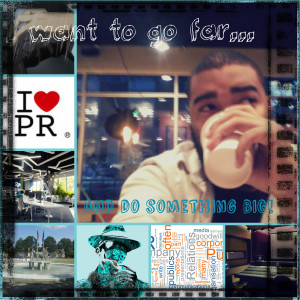-
Recent Posts
Categories
Category Archives: STEM 351
A visualization of Personal Missions and Vision Statements.
I would like to work for either a public relations firm or video game production studio. During this time I would like to learn about the different workings of either options in the pursuit of one day starting my own firm or studio. My goal is to create a brand that everyone will recognize. I want to solve problems using creativity, wit, and charm. while inspiring others to also attend follow in my footsteps. I want to wake up every morning loving what I do.
The Tutorial and Let’s Play I haven’t been able to upload
In the video I explained the process of simple code, but what I forgot to do was explain the last code that was displayed on the screen. That was complete my fault. The last code I used in the video was an example of what I am going to be using for my final project. I should have made that clearer, and I realize that I didn’t do a good job of articulating that. (Rather I suck at explaining things anyways I’ve noticed.) The code in this video is a simple code that uses transitions and switches over to text. It’s a common code template that is used for role playing in fourm sites and also used for displaying one’s work. I want to use this style, because it’s not as frequently used like many others. Also what I am trying to do is find a site that can handle this code and many other codes and post them up like they are pieces in a gallery. That way my audience can sift through each piece without having to exit out of one thread or one page to look at another page to get to my creations. Hopefully this idea can be finished by the end of week 15
Aspects of Negro Life and Pathos
Aaron Douglas’s Magisterial Aspects of Negro Life depicts the history of African American culture from slavery to the Harlem Renaissance through visually coherent graphics. Referencing back to an earlier example used in a previous analysis, in chapter 3 of Rhetoric and Civic Life, we as a global culture are described as living in a “visual culture.” In this visual culture images are distinguished by the use of visual forms of communication. To understand this type of form of culture we look at Aaron Douglas’s example to understand: visual aesthetics (content, color, and spatial organization) as it pertains to the use of pathos as a rhetorical appeal.

by Aaron Douglas
Content
Content is what is shown in an image. Content is the literal statement that an artist makes to an audience. The first image we look at under Aaron Douglas’s Magisterial, is called “into bondage.” In this image the audience is shown a silhouetted image of slaves in bondage walking through the Caribbean. The audience is never shown faces, but is shown the different actions of each slave as they migrate in this image. The ship leans over to the right on an ocean that has troubled waves. The slave centered to the front looks up at a shooting star as his fate is sealed. The content is interesting, because it appeals to your need to analysis the picture closer than you would have if it was just a picture of sad faces painted with shades of blue.
Color
Color is an interesting feature in Aaron Douglas’s “into bondage.” In the picture, Douglas uses shades of blues, reds, and violets to highlight the background and foreground of the image. The blues use to shade and paint the migrating slaves are used to represent the somber and melancholy feeling that can be seen in that moment. The red leaves give the audience a sense of danger of leaving to this unknown area. The green ship and water can be interpreted as a sickly adventure that leads to nothing but disaster. The gold chain on the slaves can be interpreted as the money being made to hold these people down as they are being captured and used as property.
Spatial Organization
Spatial Organization is the distance between different objects in an image. Spatial Organization is important because distance can also give the audience different emotions or ideas as to how to feel. In “into bondage”, the slaves are distanced from each other with one slave placed to side on their knees, another slave is drawn towards the center of the picture looking up, and a group of slaves pushed towards the background of the image. Looking at the spatial distance we can see different types of or levels of sadness. The centered slave is looking up at the star representing that he’s looking for something to change his fate. The slave on the far left can be interpreted as a slave looking for answer from above, hoping that answers can come to him. The slaves in the background can be interpreted as those who have accepted their fate as they are being led to the unknown and turbulent future the shift in the far background might bring.

